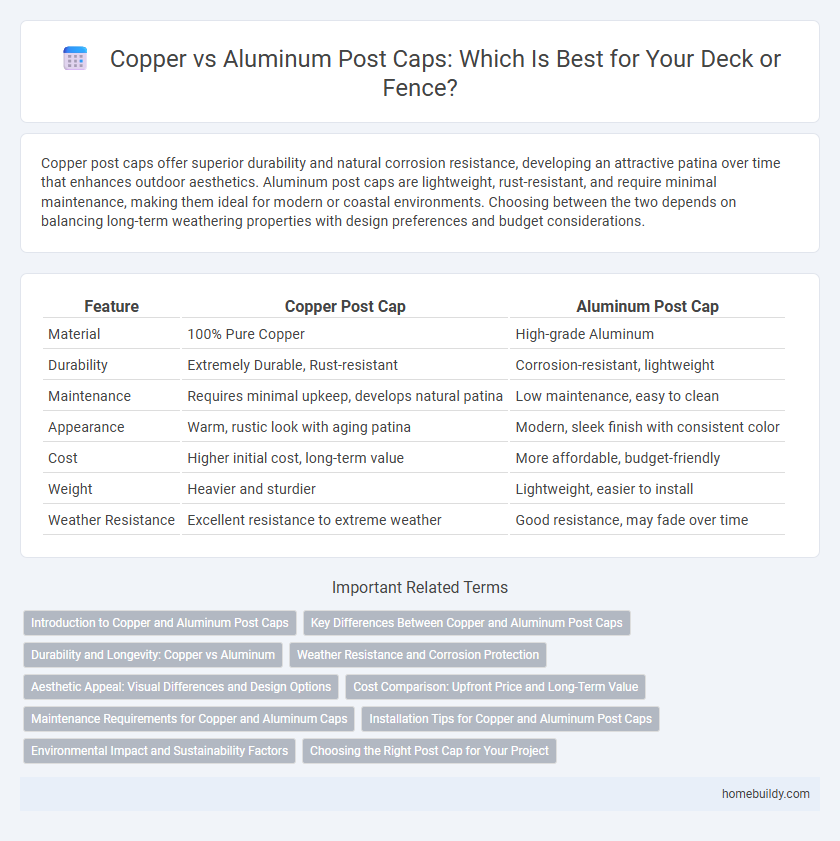Copper post caps offer superior durability and natural corrosion resistance, developing an attractive patina over time that enhances outdoor aesthetics. Aluminum post caps are lightweight, rust-resistant, and require minimal maintenance, making them ideal for modern or coastal environments. Choosing between the two depends on balancing long-term weathering properties with design preferences and budget considerations.
Table of Comparison
| Feature | Copper Post Cap | Aluminum Post Cap |
|---|---|---|
| Material | 100% Pure Copper | High-grade Aluminum |
| Durability | Extremely Durable, Rust-resistant | Corrosion-resistant, lightweight |
| Maintenance | Requires minimal upkeep, develops natural patina | Low maintenance, easy to clean |
| Appearance | Warm, rustic look with aging patina | Modern, sleek finish with consistent color |
| Cost | Higher initial cost, long-term value | More affordable, budget-friendly |
| Weight | Heavier and sturdier | Lightweight, easier to install |
| Weather Resistance | Excellent resistance to extreme weather | Good resistance, may fade over time |
Introduction to Copper and Aluminum Post Caps
Copper post caps offer exceptional durability and develop a unique patina over time, providing both protection and aesthetic appeal to wooden posts. Aluminum post caps are lightweight, corrosion-resistant, and require minimal maintenance, making them ideal for long-lasting outdoor use. Both materials enhance the lifespan of fence or deck posts while adding distinct visual character to outdoor structures.
Key Differences Between Copper and Aluminum Post Caps
Copper post caps offer superior durability and naturally develop a protective patina that enhances corrosion resistance, making them ideal for long-term outdoor use. Aluminum post caps are lightweight, more cost-effective, and resistant to rust but may lack the same level of strength and weathering properties as copper. The choice between copper and aluminum post caps depends on factors like budget, aesthetic preferences, and environmental exposure.
Durability and Longevity: Copper vs Aluminum
Copper post caps offer superior durability due to their natural resistance to corrosion and ability to develop a protective patina over time, which enhances longevity and reduces maintenance needs. Aluminum post caps resist rust and are lightweight, but they may dent or degrade faster under harsh weather conditions compared to copper. When prioritizing long-term performance, copper post caps provide a more robust solution for protecting and extending the life of wooden posts.
Weather Resistance and Corrosion Protection
Copper post caps offer superior weather resistance and corrosion protection due to their natural patina that forms over time, creating a durable barrier against rain, sun, and temperature fluctuations. Aluminum post caps resist rust and corrosion by forming a protective oxide layer, making them lightweight and ideal for coastal or humid environments. Both materials provide long-lasting protection, but copper excels in durability and aesthetic aging, while aluminum is valued for maintenance-free performance.
Aesthetic Appeal: Visual Differences and Design Options
Copper post caps offer a warm, rich patina that evolves over time, enhancing traditional and rustic aesthetics with natural oxidation turning from bright metallic to deep green hues. Aluminum post caps provide a sleek, modern look with a consistent finish available in various powder-coated colors, resistant to rust and fading, ideal for contemporary and minimalist designs. Design options for copper emphasize handcrafted, ornate details, while aluminum caps cater to clean lines and customizable shapes, allowing greater versatility in architectural styles.
Cost Comparison: Upfront Price and Long-Term Value
Copper post caps have a higher upfront cost, typically ranging from $15 to $30 per cap, due to their durability and aesthetic appeal. Aluminum post caps are generally more affordable, costing between $8 and $20 per cap, but may require replacement more frequently because they are less resistant to corrosion. Over time, copper post caps offer better long-term value by minimizing maintenance expenses and enhancing structural longevity despite the initial investment.
Maintenance Requirements for Copper and Aluminum Caps
Copper post caps require minimal maintenance due to their natural patina that protects against corrosion and weathering, eliminating the need for frequent cleaning or sealing. Aluminum post caps demand periodic inspection and cleaning to prevent oxidation and maintain their appearance, often benefiting from a protective powder coating that enhances durability. Both materials offer long-lasting protection, but copper caps excel in low-maintenance benefits because of their self-healing properties.
Installation Tips for Copper and Aluminum Post Caps
For efficient installation of copper post caps, ensure the posts are clean and dry to maximize adhesive bond, and use a high-quality, UV-resistant silicone sealant to prevent corrosion and water infiltration. Aluminum post caps require pre-drilled holes to avoid metal warping and should be secured with stainless steel screws to resist rust and maintain structural integrity. Both materials benefit from regular inspection and touch-ups with protective coatings to extend lifespan and preserve aesthetic appeal.
Environmental Impact and Sustainability Factors
Copper post caps offer superior durability and corrosion resistance, significantly reducing the need for frequent replacement and minimizing environmental waste. Aluminum post caps are lightweight and recyclable but require more energy-intensive production processes, leading to a higher carbon footprint. Choosing copper post caps supports sustainability through longevity and reduced environmental impact over their lifecycle.
Choosing the Right Post Cap for Your Project
Copper post caps offer superior durability and develop a natural patina over time, making them ideal for weather-resistant, long-lasting projects, while aluminum post caps provide lightweight, rust-free protection with a modern aesthetic. Consider copper for traditional, high-end installations requiring strength and longevity, and aluminum for cost-effective, low-maintenance solutions in coastal or humid environments. Choosing between copper and aluminum post caps depends on environmental conditions, budget constraints, and desired visual impact for your outdoor structure.
Copper Post Cap vs Aluminum Post Cap Infographic

 homebuildy.com
homebuildy.com